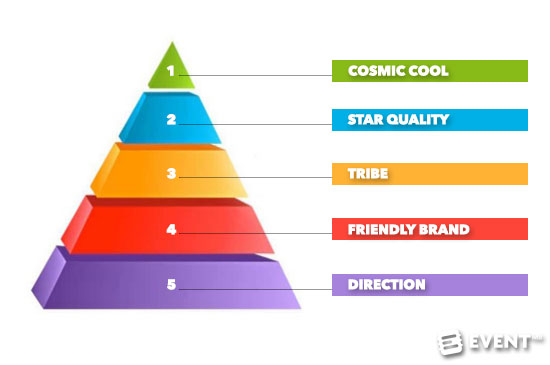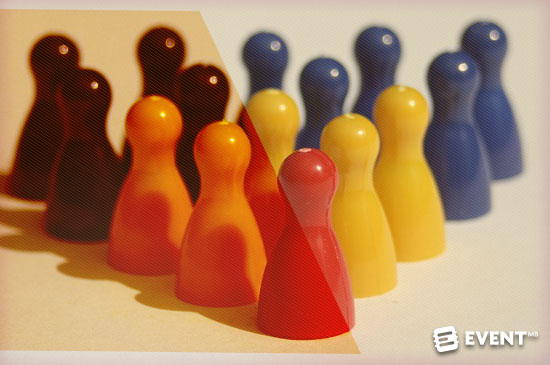Maslow knew a lot about human needs, but event attendees have their own hierarchy of needs beyond free WiFi. Are you meeting these attendee needs for a better event experience?
A starving man isn’t worried about self-perfection, at least not according to Abraham Maslow who was best known for his Hierarchy of Needs. For those of you who don’t remember beginner’s psychology, Maslow deduced that there were five stages of motivational needs people had from basic to self-fulfillment. He believed one had to satisfy the lower needs before reaching the higher ones that allowed us to fulfill our potential.
What is Maslow’s Hierarchy of Needs?
He believed at the most basic level we need things to stay alive. We have physiological needs that must be met such as food, water, and rest. Once those are met, we become concerned with more advanced (yet still basic) needs of safety and security. After we have what we need to survive and be comfortable, we long for relationships. Next we want to feel accomplished among peers and community. Finally, we desire to meet our full potential. We wonder why we’re here and what we can give back.
Attendees Have Needs Too
It’s interesting to consider your attendees’ needs as they apply to a hierarchy. What would you name as their basic needs or their more advanced? At first glance, you might place “strong and free WiFi” at the top. After all, you get enough complaints about those sorts of things. But what is it your attendees need? And more importantly — how can you help them by providing these needs?
Let’s think of the hierarchy as essential to your attendees’ enjoyment of the occasion. Without meeting their different need levels, you won’t have a successful event. Also, if you fail to meet lower needs, they will not enjoy the experience. Interestingly enough, Maslow noted that only 1 in 100 people achieves the self-actualization level, mainly because society places greater importance on the lower needs. Applying our correlation of Maslow’s needs to those of event attendees – and the more you help them meet their needs, the happier they are with the event – does that mean it’s impossible to make everyone happy?
A Hierarchy of Needs for Event Attendees

The New Attendee Hierarchy of Needs
It’s easy to use an identical base level to Maslow’s Hierarchy for events. After all, people don’t want to be hungry, thirsty, or cold there either. But let’s assume those needs are met by the fine caterers and venue you employ. What do attendees want from you? What is the very least they expect from your event? We’ll start at the most basic want:
Attendees Want to Know What They’re Doing (Direction)
They’ve waited months for this event and it’s finally here. Now what? The first thing people want when they arrive is to know someone’s “got the reins.” They want to see organization because it instills confidence in them that their needs will be taken care of, that they’ll have an enjoyable time, and that things will go as they envisioned them.
When first impressions are those of disorganization and chaos, attitudes erode quickly after that. Sometimes it begins at the event registration table (if you’re still doing that). Other times it begins earlier at hotel check-in with a lost reservation. Some things are under your control and some things are not, but the more you can do to ensure they feel attended to right away, the better.
Since you can’t be in all places at all times, use technology to help. A user-friendly app can give attendees the information they need quickly.
Attendees Want to Feel Welcomed and Get What They Came For (Friendly Brand)
After they know where they’re going and what they’re doing, attendees want to feel welcomed and valued. If it’s the first time they’re attending the event, they want to feel (quickly) that this event is what they thought it would be. It needs to be true to your branding and marketing.
Your event should be a continuation of what you promised in your marketing. It should flow from landing page to opening session, with no disjointed moments causing people to wonder where they are. For instance, if you’re billing your conference as “Innovation Brought to Life” you best get rid of that registration table and paper check-in. Even the airlines did that years ago. (Poor registration table. It’s not getting any love here.)
Attendees Want a Group of their Own (Tribe)
People can forgive cold food but if they’re sitting all alone looking at their cold chicken dish, you can imagine it will taste twice as bad. People come to events to meet others in a face-to-face environment, to build friendships with colleagues, to meet people in the industry, to have fun and be social. If they didn’t, we could all sit slouched in our chairs watching events on our laptop the way some people binge watch Netflix shows.
Helping people get connected is one of the strongest ways you can increase retention. People will come for people. There are writers’ conferences, for instance, that have retention rates in the high 90s because the same writers come every year to spend time with one another, just as much as they do the courses.
Strengthening relationships like that, safeguards your events from the “slings and arrows of outrageous fortune.” Those little bumps that make people swear they’ll never attend again are smoothed over by the idea that they will see their tribe next year.
Attendees Want to Be Lauded (Star Quality)
Events provide a number of ways to make attendees feel like stars. The easiest is remembering people and their preferences. But this can also be done through retweeting their content, posting them to a leaderboard, gamifying the event, and giving out awards. Another thing that helps people feel like a star is circulating their content. If they write about your event, you should share it.
Look for opportunities to showcase individuals often. Social media is a great platform for this, so are contests.
Attendees Want to Be a Part of Something Larger than Themselves (Cosmic Cool)
This need means several things. If the attendee has been to the event many times and all of her needs are met, you’ll find she may want to do more. This could include helping in a welcome reception, being part of a “Give Back” community service project some multi-day conferences do, or generally being of help to the first-timers.
Look for ways you can reach this group and entice them into playing more of a mentor role. Make sure there are adequate tools in place for sharing experiences. Content is also important to this group as they want to be seen as a leader professionally.
The other aspect of this that is popular with events like Comic Con or South by Southwest, is the overall cool of being in attendance. The experience is as important as the learning. While this may not seem all that elevated, and if you’re wondering why this is at the top, that sense of “cosmic cool” is what creates amazing ambassadors and a cult-like following. These attendees begin to identify as the event. They become intertwined with your event the same way fans who love Star Trek refer to themselves as “Trekkies.”
In Conclusion
Maslow’s Hierarchy of Needs provides an interesting base at which to examine your attendees’ needs. Yes, attendees are human so they still have all of Maslow’s recognized needs, but from an event perspective they’re expecting a little more. If you help them meet and achieve these needs, your event will be more successful.
The needs laid out here are important but at the pinnacle of these needs, every event planner know it’s still free WiFi with a strong signal.





